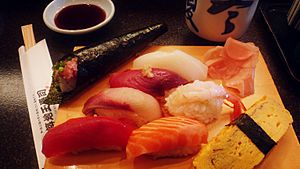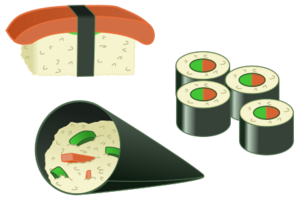Sushi facts for kids

Sushi platter
|
|
| Alternative names | すし, 寿司, 鮨 |
|---|---|
| Course | appetizer, main dish |
| Place of origin | Japan |
| Associated national cuisine | Japanese cuisine |
| Serving temperature | cold |
| Main ingredients | vinegared rice |
| Ingredients generally used | seafood and vegetables |
Sushi (寿司) is a famous traditional food from Japan. It is also very popular in many other countries. These include America, Canada, and the UK.
Sushi is made with special rice. This rice is mixed with vinegar, salt, and sugar. Sushi often has raw or cooked seafood. Sometimes it also includes vegetables. Sushi can be wrapped in a sheet of seaweed called nori.
There are many different kinds of sushi. The most common type in Japan is nigirizushi. This is a small piece of fish placed on top of sushi rice. Sometimes other ingredients like egg are used instead of fish.
Makizushi is another type. It has rice rolled around fish or vegetables. In America, makizushi is more popular than nigirizushi. Another kind is temaki, also known as a hand roll. This sushi is shaped like a cone. The nori seaweed wraps around the rice, fish, and vegetables inside.
You can eat sushi with your hands or with chopsticks. People often eat sushi with soy sauce and wasabi. Gari, which is sweet, pickled ginger, is also common. It helps to clean your taste buds between different types of sushi.
In Japan, some sushi restaurants have "conveyor-belt shops." These are called kaiten zushi. Plates of sushi move along a belt past the customers. People can pick up the sushi they want. The color of the plate shows how much the sushi costs. This way of serving sushi is becoming popular in other countries too.
Contents
History of Sushi
The idea of sushi started in Southeast Asia around 400 BC. Back then, it was called 'narezushi'. Originally, people ate only the fish, not the rice.
Later, a style called 'namanarezushi' came to Japan. This style combined fish with rice.
What we call "sushi" today was created by Hanaya Yohei (1799–1858). This was at the end of the Edo period in Edo (now Tokyo). Hanaya's sushi was an early type of fast food. It was not fermented, so it was made quickly. It was also easy to eat with your hands. This sushi was first known as Edomae zushi. This is because it used fresh fish caught in Edo Bay. Today, the fish usually does not come from Tokyo Bay. But this type of sushi is still formally called Edomae nigirizushi.
Health and Safety Tips for Sushi
Eating sushi, like most foods, has some things to consider for your health. But most risks can be avoided if the sushi is made correctly.
Some large fish, like tuna (especially bluefin), can have higher levels of mercury. Eating a lot of tuna over time can lead to too much mercury in your body.
It's rare to get sick from raw fish today. This is because good sushi chefs follow strict rules. They often freeze fish to very cold temperatures. This helps to prevent any tiny organisms that could cause problems.
Types of Sushi Around the World
The kinds of sushi can be different in each country.
- nigirizushi (Japan)
- makizushi (United States)
- uramakizushi (Europe)
Popular Sushi Restaurants in Japan
Here are some well-known sushi chain restaurants in Japan:
- Kappa sushi
- Sushiro
- Kurazushi
- Hamazushi
- Choushimaru
Images for kids
-
Sushi by Hiroshige in the Edo period
-
Ehōmaki with a setsubun mask
-
Sea urchin roe "gunkanmaki"
-
Norway roll (ノルウェー巻き). A Norwegian businessman introduced salmon for sushi in Japan in the 1980s.
-
A sushi chef preparing nigirizushi in Kyoto, Japan
-
Sheets of nori seaweed.
See also
 In Spanish: Sushi para niños
In Spanish: Sushi para niños





















